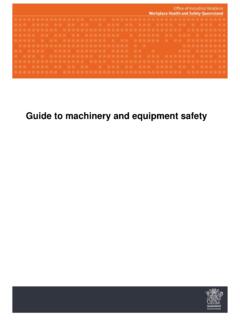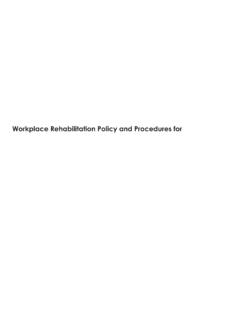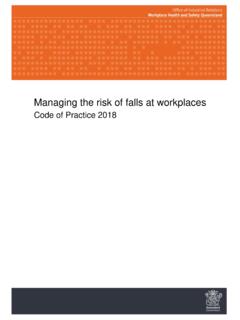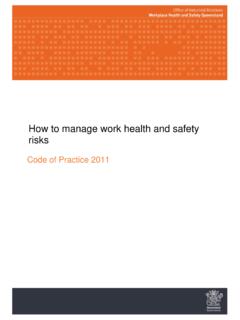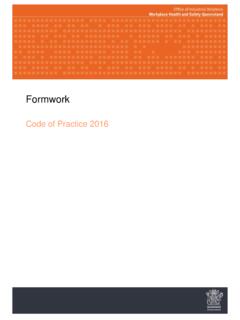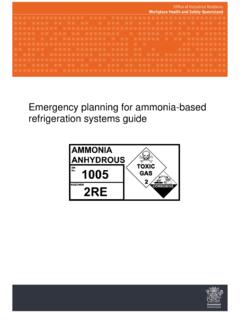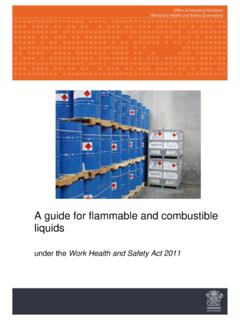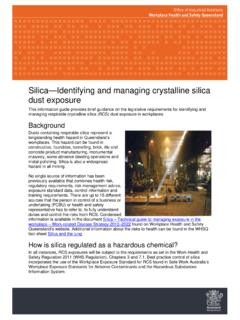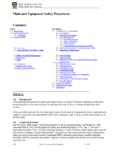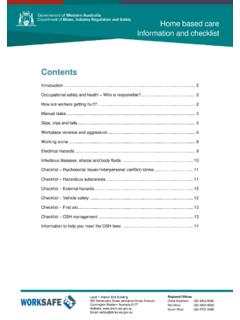Transcription of Welding processes Code of Practice 2021
1 Welding processes Code of Practice 2021 PN12624 ISBN Creative Commons This copyright work is licensed under a Creative Commons Attribution-Noncommercial International licence. To view a copy of this licence, visit In essence, you are free to copy, communicate and adapt the work for non-commercial purposes, as long as you attribute the work to Safe Work Australia and abide by the other licence terms. Welding processes Code of Practice 2021 Page 3 of 40 Contents Foreword .. 4 1. Introduction .. 5 What is Welding ? .. 5 Who has health and safety duties in relation to Welding processes ? .. 5 What is involved in managing risks associated with Welding processes ? .. 9 2. The risk management process .. 10 Identifying the hazards .. 10 Assessing the risks .. 10 Controlling the risks .. 11 Maintaining and reviewing control measures.
2 12 3. Specific hazards and control measures .. 13 Airborne contaminants .. 13 Radiation .. 15 Electrical risks .. 16 Fire and explosion .. 18 Burns and exposure to 20 Compressed and liquefied gases .. 21 Noise .. 22 Lead .. 22 Other hazards .. 24 4. Other hazards and control measures .. 26 Ventilation .. 26 personal protective equipment (PPE) .. 29 Maintenance of equipment .. 32 5. Health monitoring .. 33 Appendix A Glossary .. 35 Appendix B By-products of Welding .. 38 Welding processes Code of Practice 2021 Page 4 of 40 Foreword This code of Practice on how to manage the risks associated with Welding processes in the workplace is an approved code of Practice under section 274 of the Work Health and Safety Act 2011 (WHS Act). An approved code of Practice is a practical guide to achieving the standards of health, safety and welfare required under the WHS Act and the Work Health and Safety Regulation 2011 (WHS Regulation).
3 Under section 26A of the WHS Act duty holders must comply with an approved code of Practice or follow another method, such as a technical or industry standard, if it provides an equivalent or higher standard of work health and safety than the standard required in this code. A code of Practice applies to anyone who has a duty of care in the circumstances described in the code. In most cases, following an approved code of Practice would achieve compliance with the health and safety duties in the WHS Act, in relation to the subject matter of the code. Like regulations, codes of Practice deal with particular issues and do not cover all hazards or risks that may arise. The health and safety duties require duty holders to consider all risks associated with work, not only those for which regulations and codes of Practice exist. Codes of Practice are admissible in court proceedings under the WHS Act and WHS Regulation.
4 Courts may regard a code of Practice as evidence of what is known about a hazard, risk or control and may rely on the code in determining what is reasonably practicable in the circumstances to which the code relates. An inspector may refer to an approved code of Practice when issuing an improvement or prohibition notice. This may include issuing an improvement notice for failure to comply with a code of Practice where equivalent or higher standards of work health and safety have not been demonstrated. Scope and application This code is intended to be read by a person conducting a business or undertaking (PCBU). It provides practical guidance to PCBUs on how to manage health and safety risks associated with Welding processes in their workplace. This code may be a useful reference for other persons interested in the duties under the WHS Act and the WHS Regulation.
5 Although this code focuses on Welding processes , it may also be relevant to manage the risks associated with allied processes . Welding and allied processes involve similar hazards and in some cases the same risk control measures can be implemented. There are many different types of allied processes including metal preparation, metal cutting, gouging, brazing and soldering which need specific control measures. For more guidance on allied process control measures see Health and Safety in Welding , WTIA Technical Note No. 7, published by the Welding Technology Institute of Australia. This code applies to all workplaces covered by the WHS Act where Welding is carried out and where Welding products and equipment are used and stored. How to use this Code of Practice This code includes references to the legal requirements under the WHS Act and the WHS Regulation.
6 These are included for convenience only and should not be relied on in place of the full text of the WHS Act or the WHS Regulation. The words must , requires or mandatory indicate a legal requirement exists that must be complied with. The word should is used in this code to indicate a recommended course of action, while may is used to indicate an optional course of action. Welding processes Code of Practice 2021 Page 5 of 40 1. Introduction What is Welding ? Welding is the process of permanently joining two or more materials together, usually metals, by heat or pressure or both. When heated, the material reaches molten state and may be joined together with or without extra filler materials being added. Thermoplastics, for example, can be welded together using a suitable heat source to form permanent joins. Many different energy sources can be used for Welding including gas flames, electric arcs, electric resistance, lasers, electron beams, friction, molten metal baths and ultrasound.
7 Welding includes joining methods as diverse as spot Welding , resistance Welding , forge Welding , friction Welding , braze Welding , brazing, soldering and explosion Welding . Welding is a potentially hazardous activity and precautions are required to avoid electrocution, fire and explosion, burns, electric shock, vision damage, inhalation of poisonous gases and fumes, hearing loss, and exposure to intense ultraviolet radiation. Who has health and safety duties in relation to Welding processes ? Duty holders who have a role in managing the risks of Welding processes include: persons conducting a business or undertaking (PCBUs) designers, manufacturers, importers, suppliers and installers of plant, substances or structures officers. Workers and other persons at the workplace also have duties under the WHS Act, such as the duty to take reasonable care for their own health and safety at the workplace.
8 A person can have more than one duty and more than one person can have the same duty at the same time. Early consultation and identification of risks can allow for more options to eliminate or minimise risks and reduce the associated costs. Person conducting a business or undertaking WHS Act section 19 Primary duty of care A PCBU must eliminate risks arising from Welding processes , or if that is not reasonably practicable, minimise the risks so far as is reasonably practicable. The WHS Regulation includes more specific requirements for PCBUs to manage the risks of hazardous chemicals, airborne contaminants and plant, as well as other hazards associated with Welding such as noise and manual tasks. PCBUs have a duty to consult workers about work health and safety and may also have duties to consult, cooperate and coordinate with other duty holders. Welding processes Code of Practice 2021 Page 6 of 40 Consulting workers WHS Act section 47 Duty to consult workers A PCBU must consult, so far as is reasonably practicable, with workers who carry out work for the business or undertaking and who are (or are likely to be) directly affected by a health and safety matter.
9 This duty to consult is based on the recognition that worker input and participation improves decision-making about health and safety matters and assists in reducing work-related injuries and disease. The broad definition of a worker under the WHS Act means a PCBU must consult, so far as is reasonably practicable, with contractors and subcontractors and their employees, on-hire workers, outworkers, apprentices, trainees, work experience students, volunteers and other people who are working for the PCBU and who are, or are likely to be, directly affected by a health and safety matter. Workers are entitled to take part in consultations and to be represented in consultations by a health and safety representative who has been elected to represent their work group. Consulting, cooperating and coordinating activities with other duty holders WHS Act section 46 Duty to consult with other duty holders The WHS Act requires a PCBU to consult, cooperate and coordinate activities with all other persons who have a work health or safety duty in relation to the same matter, so far as is reasonably practicable.
10 There is often more than one business or undertaking involved in Welding processes , who may each have responsibility for the same health and safety matters, either because they are involved in the same activities or share the same workplace. In these situations, each duty holder should exchange information to find out who is doing what and work together in a cooperative and coordinated way so risks are eliminated or minimised so far as is reasonably practicable. Examples of where a PCBU will have a health and safety duty include where: the PCBU engages workers to carry out work the PCBU directs or influences workers in carrying out work other persons may be put at risk from work carried out in their business or undertaking the PCBU manages or controls a workplace or the fixtures, fittings or plant at a workplace the PBCU s business or undertaking involves designing, manufacturing, importing or supplying plant, substances or structures for use at a workplace the PBCU s business or undertaking involves installing, constructing or commissioning plant or structures at a workplace.
